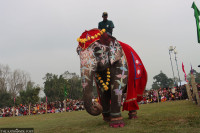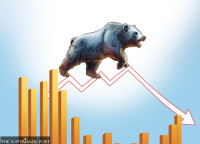Money
World Bank paints grim economic outlook for Nepal
Says the country will achieve 3.9 percent economic growth this fiscal year ending mid-July 2024, against the government target of 6 percent.
Sangam Prasain
Slow growth, stagnant wages, high inflation, inadequate investment, low private sector confidence, growing corruption and scandals, the exodus of youth to foreign countries and abrupt changes in policies.
These are the characteristics of the economy that Nepal is experiencing.
Nepal’s economy is caught in a cycle of high inflation and low growth, said Jagdish Chandra Pokhrel, a senior economist. “In the beginning, expectations were high but there is nothing on track.”
The government targets a six percent economic growth this fiscal after suffering one of the lowest growth rates—at 1.9 percent—last fiscal year.
On September 20, the Asian Development Bank projected Nepal to grow by 4.3 percent in the current fiscal year ending mid-July 2024, down from the earlier forecast of 5 percent.
On Tuesday, the World Bank said Nepal’s economy will grow by 3.9 percent in the current fiscal year.
The World Bank said in its twice-a-year country update released on Tuesday that the growth forecast is based on the assumption that there would be a gradual reduction in interest rates in the current fiscal year and that lumpy skin disease, which has infected more than 1.3 million animals since April 2023, will be under control by mid-January next year.
It said there are multiple risks to the outlook including an erratic monsoon, which could dampen agricultural growth; a renewed spike in commodity prices or continued food export bans by India, which would raise prices; and higher inflation, which could keep policy rates elevated, increase domestic debt servicing costs, and drag on growth.
“The 3.9 percent growth forecast is still optimistic,” said Pokhrel. “At the outset of the festive season, there are no economic activities. People's income has been eroded. The share market seems distorted even at the time of bonus and dividend announcement.”
“The overall situation shows the government is losing confidence,” said Pokhrel.
A series of events ranging from political paralysis and exploding inflation to growing corruption is pushing Nepal into a full-blown crisis, analysts say.
The country's economy has long been characterised by an abysmally corrupt set of policies. This trend continues, insiders say.
There is low trust in the government and as a result, the private sector is investing cautiously.
Foreign investors are closely watching the corruption and scandals in Nepal, said Pokhrel.
Experts say that the trend of the current government reversing policies overnight has raised eyebrows among investors.
On Sunday, Nepal Oil Corporation tossed out its auto pricing mechanism and rolled back fuel prices following an executive order by Prime Minister Pushpa Kamal Dahal.
“Verbal orders are replacing the law. That's anarchy,” said Pokhrel.
In the market, Krishna Bahadur Wagle, proprietor of Krishna Fancy Store at Sankata Bazaar, says customer footfall this festive season is disappointing compared to the past.
“It may be because of high inflation. The prices of newly ordered readymade clothing have increased by Rs300-400 per piece,” he said.
With prices of goods going through the roof as the festival season approaches, Nepalis are in a situation to spend carefully.
The price of cumin seed (jeera), a kitchen must-have, has reached Rs1,400 to Rs1,500 per kg. A 25 kg bag of rice costs Rs2,300 to Rs2,400. The cost of sugar has reached Rs130 to Rs140 per kg. A gas cylinder costs Rs1,895. Vegetable prices have jumped sharply.
The World Bank said that Nepal’s inflation is expected to remain elevated, reflecting the removal of VAT exemptions on select basic food items and necessities, India’s food export restrictions, and the recent global increase in fuel prices.
High inflation will weigh on the real disposable income of the people, the report said.
For a school teacher Sunil KC, celebrating the festival has become a nightmare.
He has decided not to return to his hometown Khotang for the Dashain festival this year in order to save money.
Economist Govinda Nepal said that observing the overall situation and unfolding events, it is hard to achieve more than a 3 percent growth this fiscal year.
The major driver for economic growth is agriculture and that’s too not performing, he said.
The World Bank said that the agricultural sector’s growth is projected to slow to 2.1 percent in the current fiscal year, due in part to lumpy skin disease.
A decline in the summer paddy plantation area would also contribute to lower agricultural growth this fiscal year, it said.
The multilateral funding agency has projected Nepal to grow at 5 percent in the next fiscal year. The growth rate for the next fiscal year is on the assumption that India’s export ban on selected cereal and vegetables will be withdrawn by the beginning of the next fiscal year, and Nepal’s electricity exports to India and Bangladesh will reach 1,000MW at the same time.
The World Bank said that the services sector is projected to accelerate growth to 5.1 percent in the current fiscal year.
The report said that the real estate services sub-sector should benefit from the recent amendment to the 2022 Land Use Regulations for land zoning, and the raised ceiling for lending to first-time homebuyers to Rs20 million, according to the report.
Growing numbers of international tourists and new hotels will support accommodation and food service activities.
However, the removal of the former VAT exemption on air transport—domestic flights and outbound international flights—and the imposition of a luxury tax on services provided by four- and five-star hotels and resorts could weigh on sub-sector growth, according to the report.
The report explores the export sector as the driver of external competitiveness for Nepal.
The World Bank’s analysis finds that the real appreciation of the exchange rate and continued low labour productivity are associated with Nepal’s lower exports.
As per the report, Nepal suffers from a labour productivity deficit across all three sectors – agriculture, industry, and services – compared to peer countries and its main trading partner, India.
The report said that merchandise imports are expected to rise from a seven-year low in the last fiscal year with the lifting of import restriction measures and the gradual easing of monetary policy.
However, goods imports are not expected to return to the previous fiscal year 2021-22 which saw a historic high, as the central bank also tightens working capital loan regulations and focuses on greater productive use of credit rather than expanding credit to the private sector.
The report said that electricity trade is expected to reach surplus by the next fiscal year as the country continues to expand production and exports of electricity to India and Bangladesh. Higher domestic production and consumption of electricity should also lower fossil fuel imports.
The size of Nepal’s trade in edible oils is projected to shrink over the next two years as India is expected to continue its policy of low customs duties on imports of edible oils from non-SAARC countries.
The services account will remain in deficit over the medium term as transport and travel costs, reflecting a significant number of Nepalis going abroad for work and study, continue to form a large part of the services import bill, the report said.
A recovery in services exports, as international tourist arrivals rise, is not expected to be sufficient to completely offset services imports in the current fiscal year.
Remittance inflows are expected to remain robust over the medium term, reflecting the lagged impact of near-record worker out-migration in the last fiscal year.
The government of Nepal has currently opened 111 countries for foreign employment, but most Nepali workers are concentrated in only 10 countries.
“Amid challenges, Nepal is leading the way towards operationalising its green, resilient, and inclusive development vision to shape the country’s long-term economic recovery,” said Faris Hadad-Zervos, World Bank Country Director for the Maldives, Nepal, and Sri Lanka.
“Improved external competitiveness is key to driving this recovery and enabling Nepal to compete in export markets, in terms of both prices and quality. This requires an emphasis on reforms to help increase domestic productivity and reduce the inflation differential with Nepal’s trading partners.”




 10.12°C Kathmandu
10.12°C Kathmandu













%20(1).jpg&w=300&height=200)
